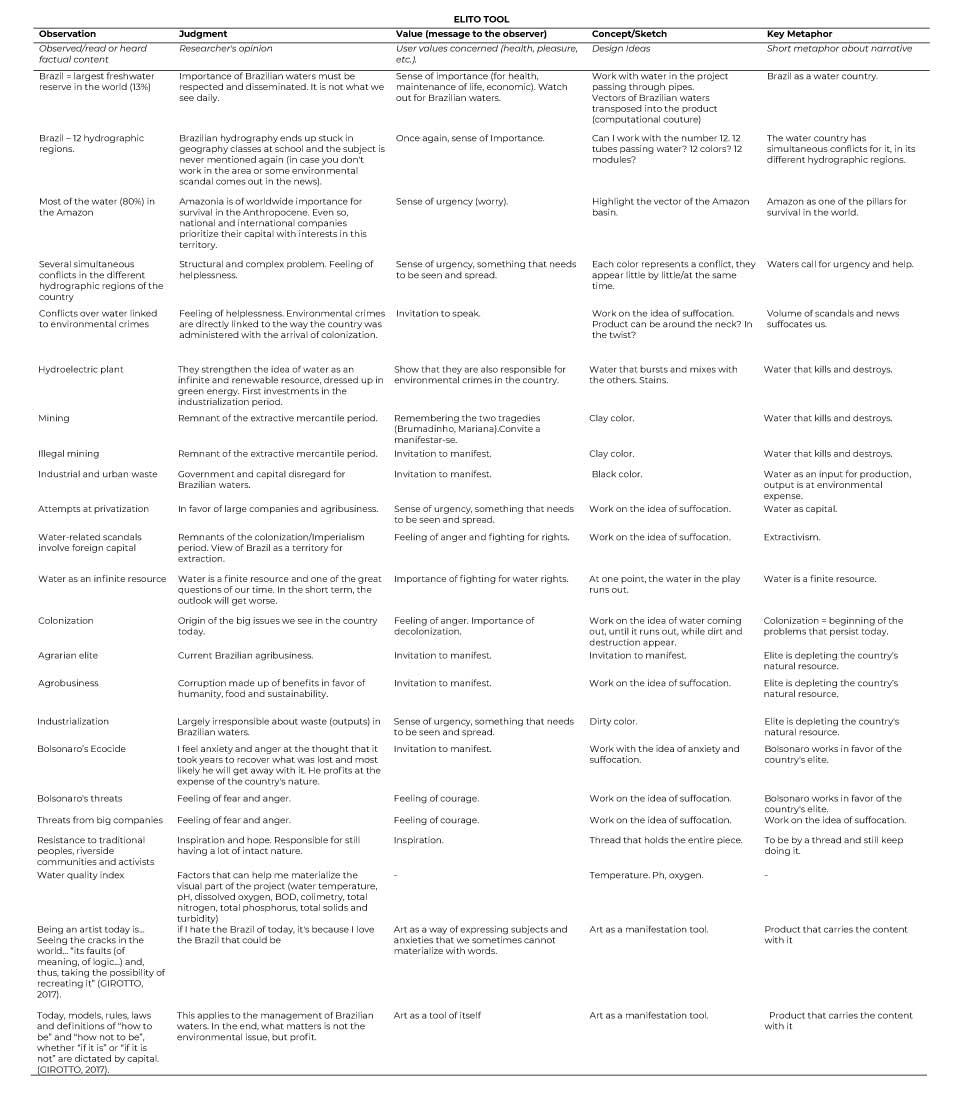TOOLS AND IDEAS¶
PROJECT TOOLS¶
design tools¶

Faced with the amount of information from the research on water and art and also my creative paralysis, it was necessary to use some tools to help me in the design process.
The tools chosen were the active requirements diagram (diagrama de requisitos ativos - REQ, in Portuguese), by Sanchez (2017) that allows visualizing all key aspects of the project in a systemic way. I used to use this tool a lot during my graduation period for fashion projects, but it works for interdisciplinary projects as well.

Subsequently, I unraveled what had been put in the previous tool in this Requirements Flowchart, by the same author (SANCHEZ, 2017), which allows the visualization and detailing of more technical and objective aspects of the project.

Finally, I filled out the ELITO Tool (SAMPAIO, 2018). This tool was essential to give me some project ideas since the first column fills in the research observation, in the second the researcher's opinions, in the third the message that you want to transfer to the observer, in the fourth the design idea and finally in the last the key metaphor.
 this image with higher quality can be seen here
this image with higher quality can be seen here
With the tools all filled and with some ideas in my head, I went to my sketches.
sketches¶
The first idea, suggested by Anastasia and Cecilia during my feedback: a kimono, where the water passes through pipes distributed in the shape of the vectors of the chosen river basins, the waters interact with each other through pH changes and the user/spectator can interact with the garment wearing it.

My second idea came after the historical research on Brazilian water management. Here we have two textile panels: while one contracts (symbolizing the extractivism of the colonial period that lasts until today), the other is being dyed and the colors of the waters interact with each other through pH changes. In this second, the tubes that release the water are distributed in vector formats of the Brazilian hydrographic basins.

Research completed, and with that my third idea: working with water as an extension of our body (something Anastasia told me during some orientation). During week 9 of Textile Scaffold I made a cotton textile waste paper in the shape of my torso (molded by CNC router) and Angela says it would be really interesting if I used that in my final project. So, thinking about this compilation, this installation would be composed of a textile torso on the floor (made by 12 modules representing the 12 Brazilian hydrographic regions). Above the piece would be the hydrographic vectors of the chosen hydrographic basins (made with tubes), which slowly drip water over the torso (again, the waters interact with each other). As the liquids drip onto the piece, it will contract slightly.

Finally, my last idea (and final idea): a textile torso suspended by a thread (to represent the resistance of Brazilian waters that is on a thread). This torso is composed of 12 modules (representing the 12 Brazilian hydrographic regions). Tubes take water to the model and dye it (the waters interact with each other, as in the other ideas). As it dyes, the model contracts (symbolizing the extractivism of the colonial period that lasts until today). The contraction works by means of a soft robot attached to the interior of the piece and happens according to the rhythm of the heartbeat, the more it paints, the faster the beat, giving the idea of tachycardia. (something I did during week 12 of soft robot).

final idea¶
-
Suspended torso - idea of water as an extension of ourselves;
-
The torso is composed of 12 modules - 12 Brazilian hydrographic regions;
-
4 colors slowly dye the torso (industrial pollution, mining, hydroelectric plants and other problems);
-
while dyeing - the torso contracts little by little, through an internal vacuum (criticism of colonization and extractivism, where the vision of water as an infinite resource begins);
-
The piece is dyed with the aid of air/vacuum/water pumps. They pump the bioink at the speed of the heartbeat (the more stains, the faster it accelerates), to bring the idea of anxiety and urgency about the water issue;
-
The torso is held by a thread, to bring the idea that Brazilian waters are on a thread, showing the resistance works.
-
The entire act is recorded, the final result of the project is a short video of the installation.


REFERENCES¶
tools¶
SAMPAIO, Claudio Pereira de. Flows: integrated model of solid waste R&D: value creation based on leadership, creative groups, design and sustainability. 2013. 2 v. Thesis (Doctorate) - Design Course, University of Lisbon, Lisbon, 2017. (free translation)
REQ AND REQUIREMENTS FLOWCHART
SANCHES, Maria Celeste de Fatima. Fashion and Design: methodological strategies in design. São Paulo: Estação das Letras e Cores, 2017. (free translation)